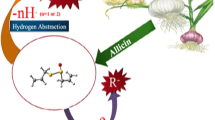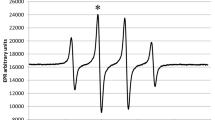Abstract
Dehydroascorbate (DHA) has been shown to possess vitamin C like activities as well as to protect the lens against oxidative stress and cataract formation. The results presented here suggest that some of the beneficial effects of DHA can be attributed to its property of undergoing peroxidative decarboxylation and of \(O_2^{\underset{\raise0.3em\hbox{$\smash{\scriptscriptstyle\cdot}$}}{ - } } \) scavenging. Incubation of 1-14C-DHA with peroxide at physiological pH has been found to liberate 14CO2 in quantitative yields, with recovery of 79–94%. The recovery increases with the increase in the amount of DHA used. Its \(O_2^{\underset{\raise0.3em\hbox{$\smash{\scriptscriptstyle\cdot}$}}{ - } } \) scavenging activity was apparent by inhibition of \(O_2^{\underset{\raise0.3em\hbox{$\smash{\scriptscriptstyle\cdot}$}}{ - } } \) dependent reduction of ferricytochrome c and nitroblue tetrazolium. The authenticity of the latter mechanism was proved by inhibition of the \(O_2^{ \cdot - } \) dependent reactions also by superoxide dismutase.
Similar content being viewed by others
References
Varma SD, Kumar S, Richards RD: Light induced damage to ocular lens cation pump: prevention by vitamin C. Proc Natl Acad Sci USA 76: 3504–3506, 1979
Varma SD, Morris SM, Bauer SA, Koppenol WH: In vitro damage to rat lens by xanthine-xanthine oxidase: protection by ascorbate. Exp Eye Res 43: 1067–1076, 1986
Devamanoharan PS, Henein M, Morris SM, Ramachandran S, Richards RD, Varma SD: Prevention of selenite cataract by vitamin C. Exp Eye Res 52: 563–568, 1991
Martensson J, Meister A: GSH deficiency decreases tissue ascorbate levels in new born rats: Ascorbate spares and protects. Proc Natl Acad Sci USA 88: 465–660, 1991
Ortwerth BJ, Olson PR: Ascorbic acid induced crosslinking of lens proteins: Evidence supporting Maillard reaction. Biochem Biophys Acta 956: 10–22, 1988
Nagaraj RJ, Monnier V: Isolation and characterisation of a blue flurophore from the eye lens crystallins: In vitro formation from Maillard with ascorbate and ribose. Biochem Biophys Acta 1116: 34–42, 1992
Roe JH, Kuether CA: Determination of ascorbic acid in whole blood and urine through 2,4-dinitrophenyl hydrazine derivative of dehydroascorbic acid. J Biol Chem 147: 399–407, 1943
McCord J, Fridovich I. Superoxide dismutase. An enzymic function for erythrocuprein (hemocuprein). J Biol Chem 244: 6049–6055, 1969
Beaucham C, Fridovich I. Superoxide dismutase: Improved assays and an assay applicable to acrylamide gels. Anal Biochem 44: 276–287, 1971
Varma SD, Morris SM. Peroxide damage to the eye lens in vitro. Prevention by pyruvate. Free Rad Res Comms 4: 283–290, 1988
Varma SD, Devamanoharan PS, Morris SM. Photo induction of cataracts in rat lens in vitro: Preventive effect of pyruvate. Exp Eye Res 50: 805–812, 1990
Devamanoharan PS, Varma SD. Peroxide damage to lens in vitro: Preventive aspects of dehydroascorbate activity. Invest Ophthal Vis Sci (supp) 34: 1298, 1993
Retsky KL, Freeman MW, Frei, B. Ascorbic acid oxidation product(s) protect human low density lipoprotein against atherogenic modification. Anti-rather than prooxidant activity of vitamin C in the presence of transition metal ions. J Biol Chem 268: 1304–1309. 1993
Author information
Authors and Affiliations
Rights and permissions
About this article
Cite this article
Devamanoharan, P.S., Morris, S.M. & Varma, S.D. Oxyradical scavenging effects of dehydroascorbate. Mol Cell Biochem 156, 131–134 (1996). https://doi.org/10.1007/BF00426335
Received:
Accepted:
Issue Date:
DOI: https://doi.org/10.1007/BF00426335




